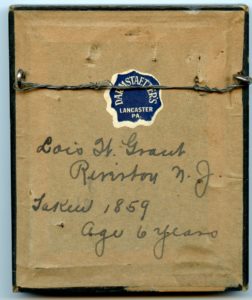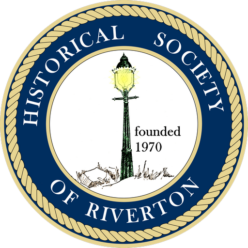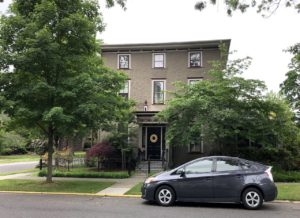We love this picture – her expression looks like her mother just told her very sternly, “now HOLD STILL!” It’s exquisite, the image just 2-1/2” high. So who was she?
Hint – her father built a number of houses here in Riverton. (Yeah, that hint wouldn’t have helped us, either…)
We love when our members and readers give us puzzles to solve. You never know where they’ll lead.
Recently, thanks to a reader’s inquiry sent to this website by Beverly DeFelice of Red Bank, NJ, whose father had collected tintypes and left her one of a little girl who was from Riverton, NJ. – from 1859 – we were faced with a mystery. Beverly knew the picture wasn’t of her father’s family, but who was it? She asked if we might know anything and does the family still exist?
(Tintypes, also called ferrotypes, were most popular in the 1860s and 70s and made with light-sensitive emulsion on a thin sheet of lacquered iron. They were much more durable than the previous photos on glass, such as daguerreotypes and ambrotypes and were very popular. The process was patented in 1856 so our example here is quite early.)
 As you’ll see, it has a gold leaf mat and on the back paper is written, in fountain pen ink and old handwriting “Lois W. Grant, Riverton, N.J. Taken 1859. Age 6 years.”
As you’ll see, it has a gold leaf mat and on the back paper is written, in fountain pen ink and old handwriting “Lois W. Grant, Riverton, N.J. Taken 1859. Age 6 years.”
But the picture wire and screweyes don’t feel like 1859 and neither does the sticker that says “Darmstaetter’s, Lancaster PA.” What’s that about?
Nothing about this rang bells, but then, with a little digging …
Ancestry.com is a great place to start. A single search of that name, in Riverton, with that approximate birthdate, and – bingo – we have the 1860 Census that shows her living in a family of 6. Unfortunately, there were no house numbers in those days, but this starts us on our quest. Her father’s name was Joel Grant, and his occupation was “carpenter.”
For those with access to an Ancestry account, we have a huge public tree we’ve been working on, called “Early Families of Riverton NJ” and we added Lois and Joel and a number of relatives to it. Have a look here: https://www.ancestry.com/family-tree/tree/108021762/family/familyview?cfpid=322186642113 (You can also use the “Tree Search” button to look for anyone else we’ve been adding, Biddles, Parrishes, etc.)

With his name, we find that more than one Ancestry user has made a tree that includes this Joel Grant – and one of them has a picture of him! Now we know what her father, that early house carpenter in Riverton, looked like.
So now we have a name of the grownup, let’s dig further …
The Historical Society of Riverton did a ton of research back in the early 1990s for our National Register Historic District nomination, and we have placed a copy of it online here: https://rivertonhistory.com/wp-content/uploads/2017/02/Historic-Riverton-District-app-1999.pdf
Since it’s a PDF, it’s easy to search for “Grant” and – wow – it turns out that our little girl’s father, Joel Grant, was the builder (and real estate developer on a modest scale) who gave us several buildings which still stand today.
Riverton National Register Historic District Inventory:
Also on our HSR website, of course, is our digitized newspaper collection, which helped with more.
Those buildings are: 401 Main, c. 1858; 406 Main Street, 1868; 400 Fulton Street, 1869; 521 Howard Street, 1881 – probably the “butcher shop of Mr. F. S. Pierce,” today much altered.
There were likely others, of course.
Since HSR board member Iris Gaughan and her husband Richard own 401 Main Street and they’ve recently researched all of the deeds for their house, it was an easy matter to find that our Joel Grant actually owned it for a long time, from 1858 to 1872. Could this have been their home at the time of shy little Lois’ photograph?

Indeed – we have a map! Attached to the National Register inventory is a dim copy of the Riverton detail of the 1860 Stone and Pomeroy Map of the Vicinity of Philadelphia, with the principal houses identified, and by golly, this one is marked “J. Grant.”
Guaranteed, this is where the little girl lived when her picture was taken.
So what became of the Grants, do they have surviving kin, and why was the tintype framed in Lancaster?
More fun with Ancestry.com and Newspapers.com came next.
Lois married Isaac Eastwood in Riverton in 1878. He was a traveling salesman of dental supplies. They seem to have lived with her parents, even after moving to Philadelphia in 1895, and never owned their own home. Lois’ mother died in 1901, her father Joel the house carpenter died in 1904, and Lois and her husband boarded thereafter until his death in 1917. His death certificate reads “cirrhosis of the liver,” an indication of long struggles for everyone.
Lois went to live in Upper Darby in the home of her grown daughter Ellen (“Ella”), and her husband, who had a nice new home in Upper Darby. He was also a traveling salesman.
The 1920s seem to have been quietly domestic for them. In 1934, our Lois died there at age 80 but then Ella lost her husband, Ralph, just three years later to a heart attack in 1937, at just 57 years of age.
Ralph had come from Lancaster County, so Ella moved there at some time after 1940, probably to live with or near her in-laws.
This would explain the “Darmstaetter’s” label on the paper on the back of the frame. Google tells us that Darmstaetter’s was a long-time photo and stationery store on Queen Street in Lancaster, so it’s easy to picture that, once she had settled in Lancaster County, Ella must have had the store reframe the tintype of her mother.
We can safely assume, then, that the fountain pen writing on the back is in Ella’s hand, recording for us the facts about her mother Lois.
Ella died there in 1953. She and Ralph had just one child, a son Robert, who was also a traveling shoe salesman like his father. He was single and had lived at home until he married at 37. At some point he went to work for the Reading Railroad.
Robert had no children, dying in 1992 at age 80.
So now we know, Lois has no living descendants. We contacted the family member on Ancestry who had the picture of Joel Grant (a descendant of one of Lois’ brothers). He was fascinated with the story but he and Bev agreed that it’d be best for the little tintype to have its new home here in our archives.
We’ll never know how Robert’s cherished photo of his grandmother in 1859 made its way to Bev DeFelice’s father’s collection, but we are very grateful to Bev for taking on its stewardship and bringing it home to Riverton.
Thank you, Bev! Moral of the story: always write names and dates on the backs of photographs! Without that, this would have been just another little picture that had lost all its meaning. (Now, how do we do this with digital photographs? …a topic for another day.) – Roger Prichard











